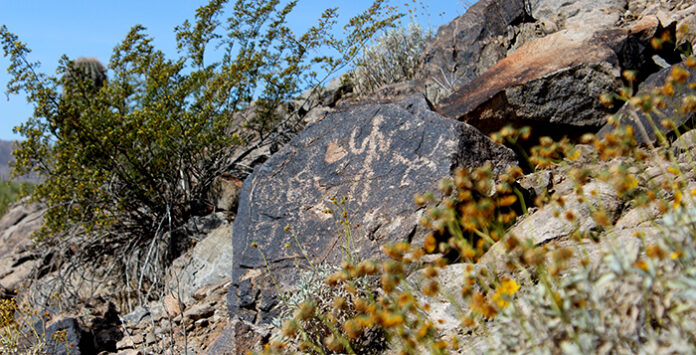
By Michelle Chance
Rural Maricopa is home to several archaeological sites that contain petroglyphs along local mountain passes.
Aaron Wright, preservation archaeologist with Archaeology Southwest, said the ancient Hohokam-style rock art was created by Native Americans between 800 and 1,300 years ago.
Their function? Wright said the petroglyphs, which adorn desert boulders, served as shrines.
“Hohokam farmers and travelers followed established travel routes and this pass was presumably one,” Wright said. “A feature that you’ll often find along ancient trails are petroglyphs.”
Nearby mountain passes once provided a migratory trail for people traveling between two large villages that used to exist on either side, Wright said.
Ancient travelers connected with their environment by etching the stone with symbols.
“Surviving in the desert and going long distances was important to them and one way the connected and obtained meaning from that was by creating and visiting shrines as they travelled,” Wright said.
Although the shrines still exist, modern roads and a lack of preservation have provided uninhibited human access to the petroglyphs, resulting in one site being vandalized with graffiti and litter, and another succumbing to theft and destruction of the rock art.
The precise locations of petroglyph sites have not been disclosed in light of previous vandalism and because most local sites are located on private property.
Archaeology Month: Petroglyph preservation between a rock and a hard place (VIDEO)




![MHS G.O.A.T. a ‘rookie sleeper’ in NFL draft Arizona Wildcats wide receiver Jacob Cowing speaks to the press after a practice Aug. 11, 2023. [Bryan Mordt]](https://www.inmaricopa.com/wp-content/uploads/2024/04/cowing-overlay-3-218x150.png)



![Maricopa’s ‘TikTok Rizz Party,’ explained One of several flyers for a "TikTok rizz party" is taped to a door in the Maricopa Business Center along Honeycutt Road on April 23, 2024. [Monica D. Spencer]](https://www.inmaricopa.com/wp-content/uploads/2024/04/spencer-042324-tiktok-rizz-party-flyer-web-218x150.jpg)



![Alleged car thief released without charges Phoenix police stop a stolen vehicle on April 20, 2024. [Facebook]](https://www.inmaricopa.com/wp-content/uploads/2024/04/IMG_5040-218x150.jpg)




![MHS G.O.A.T. a ‘rookie sleeper’ in NFL draft Arizona Wildcats wide receiver Jacob Cowing speaks to the press after a practice Aug. 11, 2023. [Bryan Mordt]](https://www.inmaricopa.com/wp-content/uploads/2024/04/cowing-overlay-3-100x70.png)